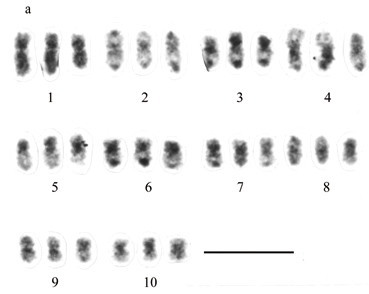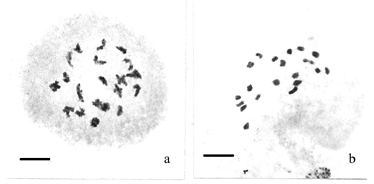Paspalum quadrifarium Lam. is a bunchgrass native to Uruguay, Argentina, and southern Brazil. Diploid, triploid, tetraploid and hexaploid cytotypes have been reported for this species of the Quadrifaria group of Paspalum. In this group, a high degree of cytogenetic homology between the genomes of several diploid species has been reported, based on meiotic pairing in interspecific hybrids; multivalent associations would thus be expected in polyploid hybrids. Karyotype analysis could provide useful information about the genomic architecture of polyploid plants; however, the fully condensed mitotic chromosomes of Paspalum do not provide enough morphological features for such an analysis. In this paper, we used mitotic prometaphase chromosomes treated with 70% acetic acid at 40 °C after cover slip removal. This process removes cytoplasm that remains from chromosome squashes and makes prometaphases available for karyological analysis. The karyotypes of a triploid (2n = 3x = 30) and a tetraploid (2n = 4x = 40) accession of Paspalum quadrifarium were studied using this technique, and evidence of segmental allopolyploidy was found in both cases. In both accessions, meiotic behavior was in accordance with that origin. This technique greatly improved the number and quality of analyzable metaphases and prometaphases on otherwise conventional slides and is recommended for plants with small chromosomes.
karyotype; meiosis; prometaphase; grasses; Paspalum







